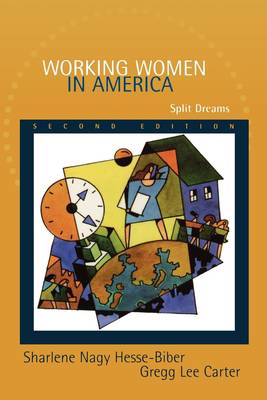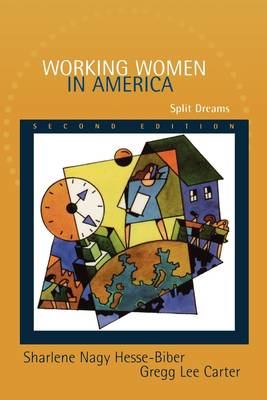
- Afhalen na 1 uur in een winkel met voorraad
- Gratis thuislevering in België vanaf € 30
- Ruim aanbod met 7 miljoen producten
- Afhalen na 1 uur in een winkel met voorraad
- Gratis thuislevering in België vanaf € 30
- Ruim aanbod met 7 miljoen producten
Working Women in America
Split Dreams
Sharlene Nagy Hesse-Biber, Gregg Lee Carter
Paperback | Engels
€ 228,95
+ 457 punten
Omschrijving
The second edition of Working Women in America: Split Dreams highlights current research on critical issues affecting American women in today's global workplace. It features updated information and examples, including extended discussions of women's activism within and outside of the workplace, the impact of globalization, the effects of the glass ceiling and sexual harassment, and women's roles in the U.S. labor movement. Retaining the focus of the first edition, this text emphasizes the continuity of women's work experience. It seeks to dispel the misconception that women's work is a recent phenomenon, when in fact women have been working throughout history. The book also addresses the constant tension and multiple roles that women must manage. The lives of working women are indeed characterized by "split dreams" most women who work are constantly juggling their work and family dreams. It is therefore misleading to concentrate solely on the workplace when seeking to understand women's position at work. Rather, one must pay attention to the connections among societal institutions. To this end, the authors argue for and utilize a structural approach-one that examines the ways in which the economy, education, the family, and the polity reflect and influence one another and help reinforce women's subordination. Only when these connections are brought to light is it possible to begin to formulate alternatives to conventional ideas concerning work, family, and gender roles.
The authors begin by situating their research in opposition to dominant sociological models of work. They then provide a thorough historical overview of women at work, carefully examining the diversity of women's experiences by race, ethnicity, class, and age. Economic, legal, political, familial, and educational institutions are also analyzed to show the ways in which they help produce and maintain inequality for women in the workplace. Working Women in America: Split Dreams intersperses first-person accounts throughout the book and provides a number of vignettes of women employed in a variety of occupations. It is an ideal text for courses in women's studies, sociology, economics, social work, and history, and fascinating reading for anyone interested in women and their work.
The authors begin by situating their research in opposition to dominant sociological models of work. They then provide a thorough historical overview of women at work, carefully examining the diversity of women's experiences by race, ethnicity, class, and age. Economic, legal, political, familial, and educational institutions are also analyzed to show the ways in which they help produce and maintain inequality for women in the workplace. Working Women in America: Split Dreams intersperses first-person accounts throughout the book and provides a number of vignettes of women employed in a variety of occupations. It is an ideal text for courses in women's studies, sociology, economics, social work, and history, and fascinating reading for anyone interested in women and their work.
Specificaties
Betrokkenen
- Auteur(s):
- Uitgeverij:
Inhoud
- Aantal bladzijden:
- 320
- Taal:
- Engels
Eigenschappen
- Productcode (EAN):
- 9780195150476
- Verschijningsdatum:
- 14/10/2004
- Uitvoering:
- Paperback
- Formaat:
- Trade paperback (VS)
- Afmetingen:
- 158 mm x 233 mm
- Gewicht:
- 449 g

Alleen bij Standaard Boekhandel
+ 457 punten op je klantenkaart van Standaard Boekhandel
Beoordelingen
We publiceren alleen reviews die voldoen aan de voorwaarden voor reviews. Bekijk onze voorwaarden voor reviews.










